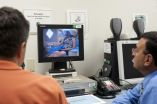Risk of stroke from cardiac catheterizations
2012-08-07
(Press-News.org) MAYWOOD, Il. -- When a patient undergoes a cardiac catheterization procedure such as a balloon angioplasty, there's a slight risk of a stroke or other neurological complication.
While the risk is extremely small, neurologists nevertheless may expect to see catheterization-induced complications because so many procedures are performed, Loyola neurologists write in the journal MedLink Neurology.
Cardiac catheterizations include diagnostic angiograms, balloon angioplasties and stent placements. More than 1.4 million procedures are successfully performed each year. Cardiac catheterizations, like all medical treatments, carry some degree of risk. But because the risk is low, neurologists rarely see patients who experience neurological complications. The purpose of the MedLink article is to raise awareness of the risks and to list treatment options for when complications do occur.
The procedure involves inserting a catheter (thin tube) in the groin or arm and guiding it to the heart. In rare cases, debris can be knocked loose from blood vessel walls, travel to the brain and trigger a stroke or transient ischemic attack (mini stroke). Tiny bubbles released from the catheter also can trigger a stroke or transient ischemic attack. And bleeding in the groin or arm where the catheter is inserted can cause peripheral nerve damage.
However, the risk is slight. And with the use of more refined techniques and smaller and softer catheters, the risk is getting even smaller, said H. Steven Block, MD, first author of the review article.
"We want to be careful to not scare people who need a cardiac catheterization from getting this beneficial procedure," Block said.
Indeed, because the incidence is so low, it is difficult to perform randomized clinical trials to determine the best treatment for catheterization-induced neurologic complications, the authors write.
"Cardiac catheterization is a very safe procedure," Block added. "A lot of neurologists may encounter neurologic complications only once or twice during their careers. But we would like to raise awareness and knowledge, so they are better prepared when a case does happen."
Block is a mid-career neurology fellow at Loyola. Co-authors are Loyola neurologists Sarkis Morales-Vidal, MD; Alejandro Hornik, MD; and Jose Biller, MD. Biller is chair of Loyola's Department of Neurology.
INFORMATION:
The article was edited by Steven R. Levine, MD, of the SUNY Health Science Center in Brooklyn. N.Y.
END
ELSE PRESS RELEASES FROM THIS DATE:
2012-08-07
Childhood obesity is on the rise in China, and children and parents there tend to underestimate body weight, according to Penn State health policy researchers.
"Because many overweight Chinese children underestimate their weight, they are less likely to do anything to improve their diet or exercise patterns," said Nengliang Yao, graduate student in health policy and administration. "If they don't make changes, they are likely to be obese and have a lot of health problems in the future -- as we often see in the United States already."
Children between the ages of 6 and ...
2012-08-07
A new study conducted by researchers at the Center for Injury Research and Policy of The Research Institute at Nationwide Children's Hospital and The Ohio State University compared medically attended noncccupational and occupational injuries among U.S. workers with and without disabilities.
The study, appearing online in the American Journal of Public Health, found that workers with disabilities are significantly more likely to experience both nonoccupational and occupational injuries than those without disabilities. Rates of nonoccupational and occupational injuries ...
2012-08-07
BOSTON – Healthcare providers should take into account differences among racial groups when using hemoglobin A1C levels to diagnose and monitor diabetes, new research from Beth Israel Deaconess Medical Center suggests.
In a study published Aug. 7 in the Annals of Internal Medicine, researchers analyzed National Health and Nutrition Survey data from 2005 to 2008 to examine the association between hemoglobin A1C levels in black and white adults and the risk for retinopathy, an eye complication of diabetes that is detectable early in the disease and can ultimately lead to ...
2012-08-07
The first controlled studies of extremely hot, dense matter have overthrown the widely accepted 50-year old model used to explain how ions influence each other's behavior in a dense plasma. The results should benefit a wide range of fields, from research aimed at tapping nuclear fusion as an energy source to understanding the inner workings of stars.
The study also demonstrates the unique capabilities of the Linac Coherent Light Source (LCLS) X-ray laser at the U.S. Department of Energy (DOE)'s SLAC National Accelerator Laboratory. While researchers have created extremely ...
2012-08-07
Scientists have discovered a biological marker that may help to identify which depressed patients will respond to an experimental, rapid-acting antidepressant. The brain signal, detectable by noninvasive imaging, also holds clues to the agent's underlying mechanism, which are vital for drug development, say National Institutes of Health researchers.
The signal is among the latest of several such markers, including factors detectable in blood, genetic markers, and a sleep-specific brain wave, recently uncovered by the NIH team and grantee collaborators. They illuminate ...
2012-08-07
By some estimates, a third of Earth's organisms live in our planet's rocks and sediments, yet their lives are almost a complete mystery.
This week, the work of microbiologist James Holden of the University of Massachusetts-Amherst and colleagues shines a light into this dark world.
In the journal Proceedings of the National Academy of Sciences (PNAS), they report the first detailed data on methane-exhaling microbes that live deep in the cracks of hot undersea volcanoes.
"Evidence has built that there's an incredible amount of biomass in the Earth's subsurface, in ...
2012-08-07
PULLMAN, Wash.—Forests hammered by windstorms, avalanches and wildfires may appear blighted, but a Washington State University researcher says such disturbances can be key to maximizing an area's biological diversity.
In fact, says Mark Swanson, land managers can alter their practices to enhance such diversity, creating areas with a wide variety of species, including rare and endangered plants and animals.
"The 1980 eruption of Mt. St. Helens, for example, has created very diverse post-eruption conditions, and has some of the highest plant and animal diversity in the ...
2012-08-07
SALT LAKE CITY, Aug. 7, 2012 – Compared with open farmland, wooded "shade" plantations that produce coffee and chocolate promote greater bird diversity, although a new University of Utah study says forests remain the best habitat for tropical birds.
The findings suggest that as open farmland replaces forests and "agroforests" – where crops are grown under trees – reduced number of bird species and shifts in the populations of various types of birds may hurt "ecosystem services" that birds provide to people, such as eating insect pests, spreading seeds and pollinating ...
2012-08-07
A program designed to encourage more healthful food choices through simple color-coded labels and the positioning of items in display cases was equally successful across all categories of employees at a large hospital cafeteria. In an article appearing in American Journal of Preventive Medicine, a team of Massachusetts General Hospital (MGH) researchers report that the interventions worked equally well across all racial and ethnic groups and educational levels.
"These findings are important because obesity is much more common among Americans who are black or Latino ...
2012-08-07
San Diego, CA, August 7, 2012 – Despite the fact that car crashes are the leading cause of death for children older than three years in the U.S. and send more than 140,000 children to the emergency room each year, new research has found that low proportions of U.S. children are using age-appropriate safety restraints and many are placed at risk by riding in the front seat. The research is published in the September issue of the American Journal of Preventive Medicine.
The American Academy of Pediatrics issued new Guidelines for Child Passenger Safety in 2011. They ...
LAST 30 PRESS RELEASES:
[Press-News.org] Risk of stroke from cardiac catheterizations




